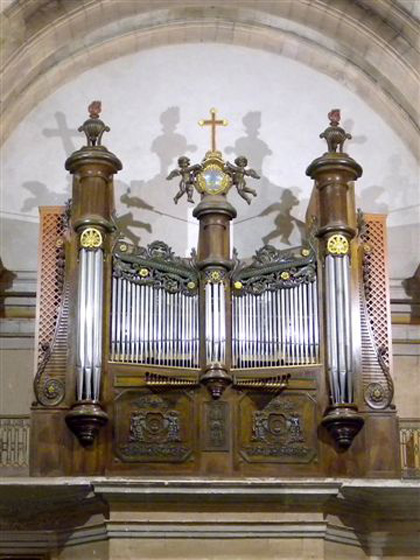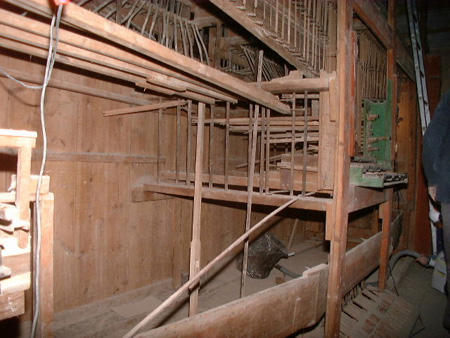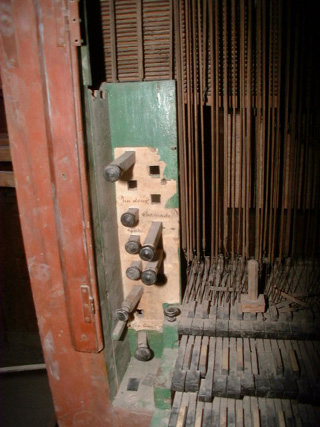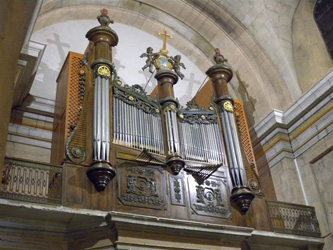

Organ : 3 keyboards , pedalboard - 26 stops

Originally, this organ was built by the organ builders Bormes and Gazeau at the beginning of the 19th century for the church "Notre-Dame du Mont" in Marseille. We have no indication concerning its exact situation in this church, the organ having been probably on the edge of the gallery, as a "positif de dos", keyboards being situated in the back.
In 1840, Fréderic Chopin, coming back from Majorca with Georges Sand, plays the organ of Bormes and Gazeau on the occasion of the famous tenor Nourit's funeral who had committed suicide because he had lost his voice. Georges Sand made a description of Chopin's performance, this one complaining about a yelling and false organ. He succeeded however in moving the public by playing, in particular, a transcription of a lied of Schubert.
Around the years 1880, the parish from Marseille sells the organ of Bormes and Gazeau to the parish of Eyguières, town in the North of Salon de Provence. The instrument is raised on a gallery in the bottom of the nave. This reassembly does not have completely succeeds, the arrangement of the instrumental part having suffered modifications for unknown reasons, we indeed noticed that the installation of the Pedal's pipes was impossible.
Around 1920, almost all of the pipework is sold by the Priest for the payment of the repair of the church's ground. Some pipes are however protected and stored (the reed pipes of white iron and the facade) in one of the rooms of the presbytery, close to the church. All the instrumental part, in its entirety, so stay in position until 2009, dates in which the complete reconstruction is begun.
Composition :
| Grand-Orgue - 54 notes | Positif - 54 notes | Récit - 30 notes | Pédale - 25 notes (Fa0 à Fa2) |
| Montre 8' | Second 8' | Bourdon 8' | Flûte 12' |
| Bourdon 8' | Flûte ouverte 4' | Flûte en bois 8' | Trompette 12' |
| Prestant 4' | Doublette 2' | Flûte 4' | Clairon 6' |
| Nazard 2 2/3' | Fourniture II rgs | Cornet III rangs | |
| Doublette 2' | Cromorne 8' | Hautbois 8' | |
| Tierce 1 3/5' | Trompette horizontale 8' | ||
| Fourniture III rgs | |||
| Cymbale III rgs | |||
| 1ère Trompette 8' | |||
| 2ème Trompette 8' | |||
| Voix humaine 8' | |||
| Clairon 4' |
Coupler : pos/G.O. - Tremulant

General description of the instrument:
We have two windchests of 108 alternated channels, positive and Great-Organ, one windchest for the "Récit", older, of 27 channels (most probably a former windchest of Echo), two windchests for the pedal from F to D2 ( 22 notes), three keyboards, plated with ebony, touched by Frédéric Chopin, and a French-style pedalboard of 21 pedal keys.
We also have a double Italian-style rollerframe for the Great-Organ and Positive, all the transmission of pedal composed of Italian-style angle rollerframes, the completeness of the stop actions and an horizontal bellow, with its pump with crank.
The restoration works concerned the complete reconstruction of the sound material, except some pipes of the original facade, the restoration of all the instrumental part, the creation of 2 extensions on the sides, to place the pedal's pipes and a restoration of the case's polychromy.
The upper floor of the case is decorated with sculptures of empire style , on the other hand, the lower case has a set of ornaments molded in resin, stuck and nailed against the panels.

The sizes of the pipes were established according to the capacity of the windchest to be able to contain them. Some drawings on the upper boards however directed the definitive establishment of the measures, then confronted with the examples of stops named on the invoice of Bormes and Gazeaux still kept (in Cuers, department of Var).)
The peculiarity lies in the construction of the reed pipes, bodies of which are entirely made of white iron : Trumpets, Clarions, Crumhorn, Oboe, Human Voice. Some wooden pipes found in the rubbish under the gallery's floor allowed us to reconstitute a treble for the open Flute of the 3rd keyboard of "Récit".
The white iron reeds have a lively sound, clear and powerful , with a lot of "Bourdon". Pipes are made of sleeves welded successively and approximately one foot width, the last sleeve is, on the other hand, made of forged lead. This type of reed stop is often met in Italy, but also in Flanders, sometimes in France (Roquemaure) in the 17th or 18th centuries. Some reed stops of Bormes and Gazeau of this kind are visible and audible in the organ of Cuers (Var).
